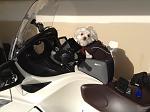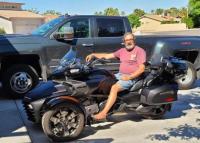|
-
 Pickup tire pressure Pickup tire pressure
I know another post asking about tire pressure. This is somewhat different, I have a Chevy pickup and replaced the tires with better brand than the OEM. The sticker inside the door and the pressure for the OEM was 37 PSI. The new tire has 45 PSI on the sidewall. When I took it to the dealer, they deflated the tires from 45 PSI to 37 PSI stating that is the best tire pressure per Chevrolet. They said regardless of the tire recommendations, the pressure should be 37PSI for best wear, milage, and comfort.
I know there are tire experts here and wanted to get the skinny on this. Thanks so much in advance, I appreciate everyone's time.
Regards,
Jim
-
Very Active Member


The pressure printed on the side wall is the maximum pressure that the tire should be run at if you are carrying the maximum the tire is rated for. As to your own vehicle you will have to determine that pressure for your self. The printed sticker is a good place to start but may not be where you will end up. I go by the 10% rule. If when warmed up the pressure grows by 10% you are ok,if by less then you have too much, if by more then not enough. Others have other formula but this one works for me.

Happy TRAils/NSD
Paul
2012 RT L
AMA 25 years Life Member
TRA
PGR
Rhino Riders Plate #83
Venturers #78
TOI

-
Ozzie Ozzie Ozzie


As Pegasus says above, the pressure printed on the sidewall of the tire is the MAXIMUM PRESSURE you can safely run in that tire and you should ONLY ever use that pressure when the tire itself is carrying the MAXIMUM LOAD it can carry, which should also be printed on the sidewall; and there's a very good chance that to reach/carry that maximum load on each tire, you'd have to SIGNIFICANTLY EXCEED the maximum load the VEHICLE itself can safely carry!! 
So your dealer is correct in that the pressure shown on the tire placard for the VEHICLE is a MUCH BETTER 'cold start' pressure than the Max Pressure @ Max Load printed on the tire's sidewall, which is almost certainly WAAAYYY TOO HIGH of a pressure in almost all circumstances for safe use under a vehicle being driven on the road - that Max Pressure @ Max Load pressure is intended more as WARNING NEVER TO EXCEED pressure as a 'cold start' pressure during that tire's operation or you risk a catastrophic failure!! I have NEVER seen a vehicle or trailer that was designed to run its tires at their Max Pressure @ Max Load pressure to start out with!! 
And given that you believe the tire you are running now is 'better' than the OEM tire (& that's very often the case, but should be based upon the tire's load &/or speed ratings being higher than OEM, then confirmed thru monitoring the tire's tread wear pattern & pressure changes during YOUR use of the vehicle.  ) there's a good chance that even 37 psi is not ideal for YOUR tires under YOUR vehicle driven the way YOU drive it on the roads YOU travel on under the conditions YOU drive in!! ) there's a good chance that even 37 psi is not ideal for YOUR tires under YOUR vehicle driven the way YOU drive it on the roads YOU travel on under the conditions YOU drive in!!  The tire placard info is a 'one size fits most' pressure for the vehicle manufacturers best guess of the expected use of that vehicle; and as such, the exact pressure shown is probably a 'good start' pressure for most, but equally as probably only rarely 'exactly correct' for any specific driver/owner & their specific vehicle/tire use and conditions! The tire placard info is a 'one size fits most' pressure for the vehicle manufacturers best guess of the expected use of that vehicle; and as such, the exact pressure shown is probably a 'good start' pressure for most, but equally as probably only rarely 'exactly correct' for any specific driver/owner & their specific vehicle/tire use and conditions! 
Again as Pegasus says above, there are a number of ways to determine a 'closer to optimum' pressure for YOU & YOUR use of that vehicle & the tire's it's now running (his preferred 10% increase method is just one of them, & a pretty reasonable one at that!  ) not the least of those being actually weighing the vehicle in its 'usual load condition' to determine the load on each tire and then looking up the tire manufacturers load/pressure tables for that tire! Most tire manufacturers have those tables available somewhere, and that's always a good place to start! Then you can always 'fine tune' that based upon your preferred option that reflects YOUR SPECIFIC use! ) not the least of those being actually weighing the vehicle in its 'usual load condition' to determine the load on each tire and then looking up the tire manufacturers load/pressure tables for that tire! Most tire manufacturers have those tables available somewhere, and that's always a good place to start! Then you can always 'fine tune' that based upon your preferred option that reflects YOUR SPECIFIC use! 
Last edited by Peter Aawen; 12-08-2020 at 01:54 PM.
2013 RT Ltd Pearl White
Ryde More, Worry Less!
-
Active Member


On my Jeep I used the chalk method. The OEM tires on my Rubicon were basically 33x10.5 tyres and I went up to 34x11.5 for better off roading traction and clearance. Obviously a larger tyre will have different optimal pressure requirements. With the chalk method, take a piece of white (or any color) child's sidewalk chalk and make a wide (about 1") mark across the tread of the tyre and roll the vehicle forward a few revolutions. Look at the mark it leaves on the tyre, it should be even all the way across. If the chalk mark fades at the edges, you have too much air. Likewise, it the mark fades in the center, you have too little air. This video uses extreme pressure differences to illustrate the point, but you get the idea... It's not too difficult to dial in the best tyre pressure with a little tryal and error.
https://www.youtube.com/watch?v=a2ST54xnhuI
John
2018 Silverado LTZ 3500HD CC LB 4X4 DRW Duramax/Allison
2019 Grand Design Momentum 381M w/Full Body Paint
2016 Can Am Spyder F3 Limited Special Series
MSgt, USAF (Ret)

 Posting Permissions
Posting Permissions
- You may not post new threads
- You may not post replies
- You may not post attachments
- You may not edit your posts
-
Forum Rules
|




 Reply With Quote
Reply With Quote



 The tire placard info is a 'one size fits most' pressure for the vehicle manufacturers best guess of the expected use of that vehicle; and as such, the exact pressure shown is probably a 'good start' pressure for most, but equally as probably only rarely 'exactly correct' for any specific driver/owner & their specific vehicle/tire use and conditions!
The tire placard info is a 'one size fits most' pressure for the vehicle manufacturers best guess of the expected use of that vehicle; and as such, the exact pressure shown is probably a 'good start' pressure for most, but equally as probably only rarely 'exactly correct' for any specific driver/owner & their specific vehicle/tire use and conditions! 



